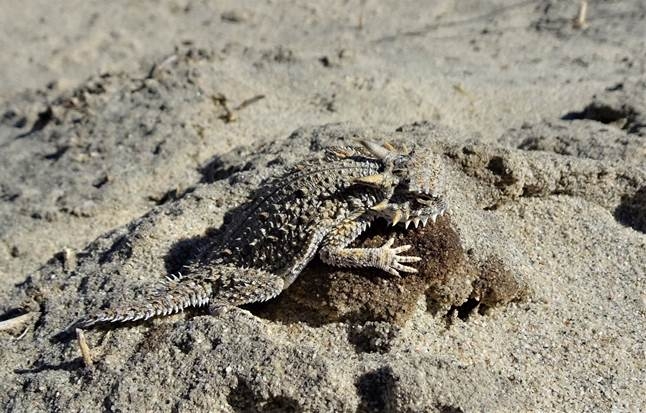A "Natural History Note" From UC California Naturalist's new lead scientist, Dr. Cameron Barrows.
We often associate spring with when nature renews itself. Flowers and baby animals are the icons of spring. Except if you are a lizard. Lizards do breed in spring and early summer; however, it takes about 60 days for those eggs to hatch. Those hatchling lizards will not emerge and greet their new world until mid-summer to early fall. Depending on the year and the availability of food, female lizards will lay anywhere from zero egg clutches (in years when there isn't enough food available produce energy-rich eggs) to one, two or three egg clutches (in years with plentiful food). Each clutch separated by about a month, the time it takes for the females to replenish their fat reserves sufficiently to provide the energy and nutrients to produce more eggs. Fall is (also) the time to celebrate nature's rebirth if you are a lizard lover.
Not all lizards lay eggs. Some, especially those at high elevations, give birth to live young. Putting your eggs in the ground when an early or late frost could kill them is not a good strategy. Keeping your growing embryos inside your body where you can move in and out of patches of warming sunlight makes much more sense. For those, typically lower elevation lizards that do lay eggs, the gravid female lizards excavate nest chambers where they deposit their eggs and where those eggs will incubate until they hatch. That process never ceases to amaze me. The mothers-to-be must dig a nest chamber that is deep enough to be not too hot or too cold, and humid enough, but not too humid (too humid might foster mold or bacteria that would kill the embryos) and not too dry (the embryos would desiccate), and she must select sites that will provide those optimal conditions for those 60 or so days before her eggs hatch. Researchers have found that lizard eggs that are incubated too warm will mature and hatch faster, but they will lack the mental acuity of those incubated cooler and slower. Mental acuity? Apparently, more time in the egg allows neurons to develop more fully. In this case it means the ability to show awareness of potential predators and then take appropriate evasive action. Being incubated too warmly means your chance of passing on your genes to the next generation is far less than those who experienced cooler-slower incubation.
My amazement does not stop there. Imagine when those eggs hatch. It will be totally dark, but they need to find their way to the surface. The mother will have back-filled the tunnel she excavated leading to her nest chamber – both to keep humidity in and so that predators do not find her eggs. In those 60 days of incubation, the tunnel to the egg chamber will have collapsed even further. Yet, despite having never-before exercised their arms and legs, the hatchlings will need to dig to the surface and be ready to both find food and avoid becoming food. Amazing beyond words.
Here in the Coachella Valley, the summer of 2020 broke the record for the number of days that the high temperatures exceeded 100 degrees F – over 150 days, five months straight of blistering heat. That was nearly three weeks more that the previous record. What does that mean for those lizard eggs that were laid before the onset of heat? If being incubated too hot results if fewer hatchlings or hatchlings less able to meet the challenges of life, what does that mean for the Coachella Valley fringe-toed lizards?
This past week the temperatures finally cooled just enough to go out on the sand dunes safely and see how those hatchlings were doing. It was a wet enough spring to have allowed the adult females to build the fat reserves to have multiple clutches; there should be plenty of hatchlings. Community Scientist Cathy Wiley (California Naturalist class of 2019) and I went out on the dunes yesterday. The numbers of hatchling fringe-toed lizards were under-whelming. There were a few, but the ratio of hatchlings to adults was 0.5 to 1. I would have predicted 2-4 to 1 based on the wet spring. The day before I had checked the somewhat cooler dune habitats along the Kim Nicol trail and found the hatchling to adult ratio to be 1.5 to 1, somewhat closer to my expectation. This is too preliminary to identify causes, but perhaps we are seeing the effects of climate change. If so, this is not good.
Perhaps even more interesting, Cathy and I found lots of hatchling flat-tailed horned lizards, and good numbers of hatchling shovel-nosed snakes. We saw the tracks of both (probably dozens of separate hatchling horned lizard tracks) and were able to follow those tracks and find the baby horned lizards on several occasions. So, these two species seemed to be doing well. What is the difference? I can only guess, but perhaps flat-tailed mothers dig deeper (cooler) nest chambers?
There is never any lack of questions to pursue, always another piece of the puzzle to fit into place.
Go outside, tip your hat to a lizard, and be safe.
